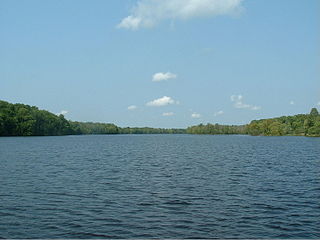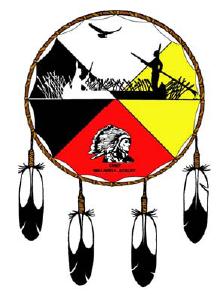Related Research Articles

The Ojibwe, Ojibwa, Chippewa, or Saulteaux are an Anishinaabe people in what is currently southern Canada, the northern Midwestern United States, and Northern Plains.

Crandon is a city in Forest County, Wisconsin, United States; it is in the northeastern part of the state, about 100 miles (160 km) north of Green Bay. The population was 1,713 at the 2020 census. It is the county seat of Forest County and is the only incorporated community in the county. The city is located adjacent to the Town of Crandon.

The Potawatomi, also spelled Pottawatomi and Pottawatomie, are a Native American people of the western Great Lakes region, upper Mississippi River and Great Plains. They traditionally speak the Potawatomi language, a member of the Algonquin family. The Potawatomi call themselves Neshnabé, a cognate of the word Anishinaabe. The Potawatomi are part of a long-term alliance, called the Council of Three Fires, with the Ojibway and Odawa (Ottawa). In the Council of Three Fires, the Potawatomi are considered the "youngest brother" and are referred to in this context as Bodwéwadmi, a name that means "keepers of the fire" and refers to the council fire of three peoples.
The Wisconsin Walleye War became the name for late 20th-century events in Wisconsin in protest of Ojibwe hunting and fishing rights. In a 1975 case, the tribes challenged state efforts to regulate their hunting and fishing off the reservations, based on their rights in the treaties of St. Peters (1837) and La Pointe (1842). On August 21, 1987, the U.S. District Court Judge Barbara Crabb ruled that six Ojibwe (Chippewa) tribal governments had the right under these treaties for hunting and fishing throughout their former territory.

The Odawa, said to mean "traders", are an Indigenous American ethnic group who primarily inhabit land in the Eastern Woodlands region, commonly known as the northeastern United States and southeastern Canada. They have long had territory that crosses the current border between the two countries, and they are federally recognized as Native American tribes in the United States and have numerous recognized First Nations bands in Canada. They are one of the Anishinaabeg, related to but distinct from the Ojibwe and Potawatomi peoples.

The Menominee River is a river in northwestern Michigan and northeastern Wisconsin in the United States. It is approximately 116 miles (187 km) long, draining a rural forested area of northern Wisconsin and the Upper Peninsula of Michigan into Lake Michigan. Its entire course, with that of its tributary, the Brule River, forms part of the boundary between the two states.

The Wolf River is a 225 mi (362 km) long tributary of the Fox River in northeastern Wisconsin in the Great Lakes region of the United States. The river is one of the two National Scenic Rivers in Wisconsin, along with the St. Croix River. The scenic portion is 24 miles (39 km) long. The river and its parent the Fox River and associated lakes are known for their sturgeon which spawn every spring upstream on the lower river until blocked by the Shawano Dam. The river flows through mostly undeveloped forestland southerly from central Forest County in the north to Lake Poygan in the south. The lake is part of the Winnebago Pool of lakes fed by both the Fox and Wolf Rivers. The Fox-Wolf basin is usually considered to be a single unified basin and the rivers themselves may be referred to as the Fox-Wolf River system.

The Menominee are a federally recognized nation of Native Americans. Their land base is the Menominee Indian Reservation in Wisconsin. Their historic territory originally included an estimated 10 million acres (40,000 km2) in present-day Wisconsin and the Upper Peninsula of Michigan. The tribe currently has about 8,700 members.

The Bad River LaPointe Band of the Lake Superior Tribe of Chippewa Indians or Bad River Tribe for short are a federally recognized tribe of Ojibwe people. The tribe had 6,945 members as of 2010. The Bad River Reservation is located on the south shore of Lake Superior and has a land area of about 193.11 square miles (500.15 km2) in northern Wisconsin, straddling Ashland and Iron counties. Odanah, the administrative and cultural center, is located five miles (8.0 km) east of the town of Ashland on U.S. Highway 2. The reservation population was 1,545 in 2020. Most of the reservation is managed as undeveloped forest and wetland, providing a habitat for wild rice and other natural resources.

The Nottawaseppi Huron Band of Potawatomi (NHBP) is a federally-recognized tribe of Potawatomi in the United States. The tribe achieved federal recognition on December 19, 1995, and currently has approximately 1500 members.

The Sokaogon Chippewa Community, or the Mole Lake Band of Lake Superior Chippewa, is a federally recognized tribe of the Lake Superior Chippewa, many of whom reside on the Mole Lake Indian Reservation, located southwest of the city of Crandon, in the Town of Nashville, Forest County, Wisconsin. The reservation is located partly in the community of Mole Lake, Wisconsin.

The Forest County Potawatomi Community is a federally recognized tribe of Potawatomi people with approximately 1,400 members as of 2010. The community is based on the Forest County Potawatomi Indian Reservation, which consists of numerous non-contiguous plots of land in southern Forest County and northern Oconto County, Wisconsin, United States. The community also administers about 7 acres (28,000 m2) of off-reservation trust land in the city of Milwaukee. According to the U.S. Census Bureau, the reservation and off-reservation trust land together have a total area of 22.72 square miles (58.8 km2). The combined population of Forest County Potawatomi Community and Off-Reservation Trust Land was 594 in the 2020 census. The nation's administrative and cultural center are located about three miles east of Crandon, Wisconsin.
The Bad River train blockade was a 1996 action on the Bad River Ojibwe Reservation in Ashland County, Wisconsin, carried out by Ojibwe activists against train shipments of sulfuric acid. The activists blocked the railroad tracks that would have brought the acid to a mine in the Upper Peninsula of Michigan. The action brought national scrutiny on the United States Environmental Protection Agency (EPA) and demonstrated the power of Indigenous rights in environmentalism.

Walter Bresette was a prominent Ojibwe activist, politician, and author most notable for work on environmental issues and Ojibwe treaty rights in Northern Wisconsin and the Lake Superior region. He founded or co-founded several organizations including Witness for Nonviolence, the Midwest Treaty Network, and the Wisconsin Green Party.

The Sandy Lake Tragedy was the culmination in 1850 of a series of events centered in Big Sandy Lake, Minnesota that resulted in the deaths of several hundred Lake Superior Chippewa. Officials of the Zachary Taylor Administration and Minnesota Territory sought to relocate several bands of the tribe to areas west of the Mississippi River. By changing the location for fall annuity payments, the officials intended the Chippewa to stay at the new site for the winter, hoping to lower their resistance to relocation. Due to delayed and inadequate payments of annuities and lack of promised supplies, about 400 Ojibwe, mostly men and 12% of the tribe, died of disease, starvation and cold. The outrage increased Ojibwe resistance to removal. The bands effectively gained widespread public support to achieve permanent reservations in their traditional territories.
The Lake Superior Chippewa are a large number of Ojibwe (Anishinaabe) bands living around Lake Superior; this territory is considered part of northern Michigan, Wisconsin, and Minnesota in the United States. They migrated into the area by the seventeenth century, encroaching on the Eastern Dakota people who historically occupied the area. The Ojibwe defeated the Eastern Dakota and had their last battle in 1745, after which the Dakota Sioux migrated west into the Great Plains. While sharing a common culture and Anishinaabe language, this group of Ojibwe is highly decentralized, with at least twelve independent bands in this region.
The Great Lakes Indian Fish & Wildlife Commission (GLIFWC) is an intertribal, co-management agency committed to the implementation of off-reservation treaty rights on behalf of its eleven-member Ojibwa tribes. Formed in 1984 and exercising authority specifically delegated by its member tribes, GLIFWC's mission is to help ensure significant off-reservation harvests while protecting the resources for generations to come.
Gogebic Taconite is an iron-ore mining company in development stage, based in Florida, with a presence in Hurley, Wisconsin. The company, owned by the larger mining organizations, Cline Resource and Development Group, is at the center of a dispute among politicians, community groups, environmental organizations, Native American tribal councils and various stakeholders because of a proposed mining project scheduled for operation in Iron and Ashland counties in northern Wisconsin.

Big Indian Farms is a remote clearing in the Chequamegon Forest west of Medford, Wisconsin where as many as 130 Potawatomi and others lived from around 1896 to 1908. In this isolated spot they were able to preserve their ancestors' culture better than if they had lived under the direct influence of the Bureau of Indian Affairs on a reservation.
The Back Forty Mine is a proposed open-pit metallic sulfide mine targeting gold and zinc deposits in Menominee County in the South Central part of Michigan's Upper Peninsula next to the Menominee River.
References
- ↑ Lee Bergquist, "Mining Gets New Backing," Milwaukee Journal Sentinel, 23–29 January 1995.
- ↑ John J. Mutter, "To Slay a Giant: The Fight to Protect the Wolf River from the Proposed Crandon Copper Mine," (Shawano, WI: Burstone-LLC, 2000) 1-158.
- ↑ Al Gedicks, What You Should Know About Exxon/Rio Algom's Proposed Mine at Crandon/Mole Lake. La Crosse, Wis.: Wisconsin Resources Protection Council, 1996.
- ↑ List of National Wild and Scenic Rivers Archived 2011-11-15 at the Wayback Machine
- ↑ Zoltan Grossman Unlikely Alliances: Treaty conflicts and environmental cooperation between Native American and rural White communities Archived 2007-07-21 at the Wayback Machine . pp. 375-379.
- ↑ Exxon Minerals Company, The Quest and The Questions. Crandon, Wis.: Public Affairs Office, Exxon Minerals Co., 1979.
- ↑ Grossman 381; 2002
- ↑ Grossman 405; 2002
- ↑ Bergquist 1A; 2002
- ↑ Rinard and Jones 1A; 2003
- ↑ Dale Alberts qtd. in Imrie; 2003
- ↑ Midwest Treaty Network; 2003